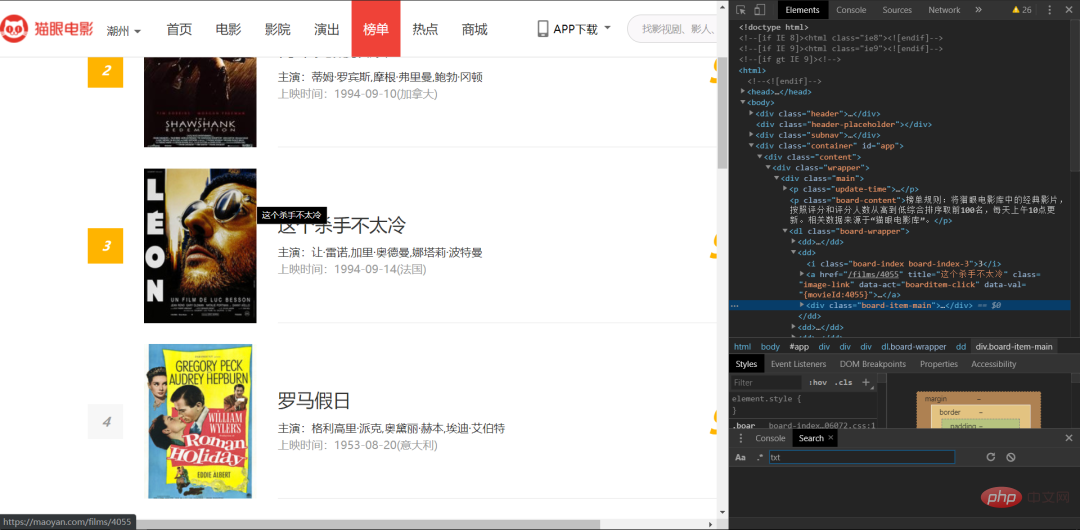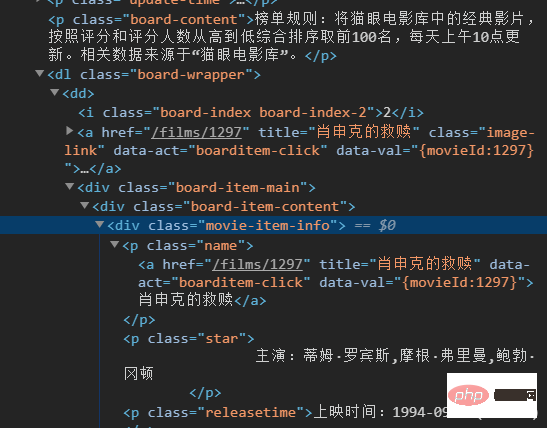 Backend Development
Backend Development
 Python Tutorial
Python Tutorial
 An introduction to regular expressions and their common matching functions in Python
An introduction to regular expressions and their common matching functions in Python
An introduction to regular expressions and their common matching functions in Python
/Introduction/
Python has added the re module since version 1.5, which Provides Perl-style regular expression patterns. The re module enables the Python language to have all regular expression functions.
The compile function generates a regular expression object based on a pattern string and optional flag parameters. This object has a series of methods for regular expression matching and replacement.
The re module also provides functions that are identical to these methods. These functions take a pattern string as their first argument.
##/re.match function/
re.match attempts to match a pattern from the starting position of the string. If the matching is not successful at the starting position, match() will return none. The syntax is as follows:
re.match(pattern, string, flags=0)
"pattern" matches the regular expression "string" and the string "flags" flag to match.
If the match is successful, the re.match method returns a matching object, otherwise it returns None.
We can use group(num) or groups() matching object function to get the matching expression.
group(num=0) 匹配的整个表达式的字符串,“group()”可以一次输入多个组号,在这种情况下它将返回一个包含那些组所对应值的元组。
下图是个实际例子:

输出结果如下图所示:

/检索和替换/
Python 的re模块提供了re.sub用于替换字符串中的匹配项。语法如下所示:
re.sub(pattern, repl, string, count=0, flags=0)
参数:
pattern : 正则中的模式字符串。
repl : 替换的字符串,也可为一个函数。
string : 要被查找替换的原始字符串。
count : 模式匹配后替换的最大次数,默认 0 表示替换所有的匹配。
flags : 编译时用的匹配模式,数字形式。
前三个为必参数,后两个为可选参数。
下图是个实际例子:

输出结果如下图所示:

/compile函数/
compile 函数用于编译正则表达式,供match() 和 search() 这两个函数使用。语法格式为:
re.compile(pattern[, flags])
参数:
pattern : 一个字符串形式的正则表达式
flags 可选,表示匹配模式,比如忽略大小写,多行模式等,具体参数为:
re.I 忽略大小写
re.L represents the special character set \w,\W, \b, \B, \s, \S depends on the current environment
re.M More Line pattern
re.S is '.' and any character including newline ('.' does not include newline)
re.U represents the special character set \w,\W, \b, \B, \d, \D, \s, \S and relies on the Unicode character attribute database
re.X To increase readability, ignore spaces and comments after '#'
/regular expression object/
re.RegexObject: re.compile() returns the RegexObject object.
re.MatchObject: group() returns the string matched by RE.
start() Returns the position where the match starts
end() Returns the position where the match ends
span() returns a tuple containing the position of the match (start, end)
/regular expression modifier - optional flag/
Regular expressions can contain some optional flag modifiers to control the matching patterns. The modifier is specified as an optional flag. Multiple flags can be specified by bitwise OR(|) them. For example, re.I| re.M is set to I and M flags:
##re.I | Make the match case-insensitive | ||||
re.L | Do localization recognition (locale-aware) matching | ||||
re.M | Multiple line matching, affecting ^ and $ | ||||
re.S | # #Make . match all characters including newlines | ||||
| re.U | Parses characters according to the Unicode character set. This flag affects \w, \W, \b, \B. | ||||
re. Regular expressions are written to be easier to understand. | /regular expression pattern/ ## The pattern string uses special syntax to represent a regular expression Expression: Letters and numbers represent themselves. Letters and numbers in a regular expression pattern match the same string. Most letters and numbers have different meanings when preceded by a backslash. Punctuation marks match themselves only if they are escaped, otherwise they represent a special meaning. The backslash itself needs to be escaped with a backslash. Since regular expressions usually contain backslashes, you'd better use raw strings to represent them. Pattern elements (such as r'\t', equivalent to \\t) match the corresponding special characters. The following table lists the special elements in the regular expression pattern syntax. If you use a pattern and provide optional flags arguments, the meaning of some pattern elements will change. Character matching Matches "python". 字符类 /实际应用/ 以猫眼电影为例。我们需要获取(电影的名字作者,上映时间)等等都可以用正则表达式来解析。 分析一下,利用正则表达式提取。 可以看到我们要的名字在一个a里面,而他们被一个div包裹着。 我们把div想象成一个盒子,可以看到div里面还有一个div 我们可以先找他上面一层的div是一个表单 分析完再实际操作一下: (.*?)表示我们要的内容 (.*?) /小结/ 1. Regular expressions are suitable for scenarios where multiple data needs to be obtained. It can get the data we want in a faster way. ## 2. This article mainly introduces regular expressions and their basic usage. For specific usage of each character, you can refer to the regular expression series articles in the preface. I hope it can help you learn more. Good understanding of the usage of regular expressions. The above is the detailed content of An introduction to regular expressions and their common matching functions in Python. For more information, please follow other related articles on the PHP Chinese website! AI-powered app for creating realistic nude photos Online AI tool for removing clothes from photos. Undress images for free AI clothes remover Generate AI Hentai for free. Easy-to-use and free code editor Chinese version, very easy to use Powerful PHP integrated development environment Visual web development tools God-level code editing software (SublimeText3) An application that converts XML directly to PDF cannot be found because they are two fundamentally different formats. XML is used to store data, while PDF is used to display documents. To complete the transformation, you can use programming languages and libraries such as Python and ReportLab to parse XML data and generate PDF documents. To convert XML images, you need to determine the XML data structure first, then select a suitable graphical library (such as Python's matplotlib) and method, select a visualization strategy based on the data structure, consider the data volume and image format, perform batch processing or use efficient libraries, and finally save it as PNG, JPEG, or SVG according to the needs. There is no APP that can convert all XML files into PDFs because the XML structure is flexible and diverse. The core of XML to PDF is to convert the data structure into a page layout, which requires parsing XML and generating PDF. Common methods include parsing XML using Python libraries such as ElementTree and generating PDFs using ReportLab library. For complex XML, it may be necessary to use XSLT transformation structures. When optimizing performance, consider using multithreaded or multiprocesses and select the appropriate library. XML beautification is essentially improving its readability, including reasonable indentation, line breaks and tag organization. The principle is to traverse the XML tree, add indentation according to the level, and handle empty tags and tags containing text. Python's xml.etree.ElementTree library provides a convenient pretty_xml() function that can implement the above beautification process. The speed of mobile XML to PDF depends on the following factors: the complexity of XML structure. Mobile hardware configuration conversion method (library, algorithm) code quality optimization methods (select efficient libraries, optimize algorithms, cache data, and utilize multi-threading). Overall, there is no absolute answer and it needs to be optimized according to the specific situation. Use most text editors to open XML files; if you need a more intuitive tree display, you can use an XML editor, such as Oxygen XML Editor or XMLSpy; if you process XML data in a program, you need to use a programming language (such as Python) and XML libraries (such as xml.etree.ElementTree) to parse. It is impossible to complete XML to PDF conversion directly on your phone with a single application. It is necessary to use cloud services, which can be achieved through two steps: 1. Convert XML to PDF in the cloud, 2. Access or download the converted PDF file on the mobile phone. It is not easy to convert XML to PDF directly on your phone, but it can be achieved with the help of cloud services. It is recommended to use a lightweight mobile app to upload XML files and receive generated PDFs, and convert them with cloud APIs. Cloud APIs use serverless computing services, and choosing the right platform is crucial. Complexity, error handling, security, and optimization strategies need to be considered when handling XML parsing and PDF generation. The entire process requires the front-end app and the back-end API to work together, and it requires some understanding of a variety of technologies. |


 ##Regular expression example
##Regular expression example

























